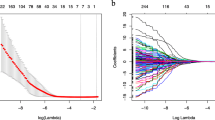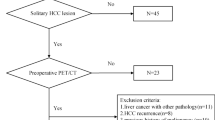Abstract
As a reliable preoperative predictor for microvascular invasion (MVI) and disease-free survival (DFS) is lacking, we developed a radiomics nomogram of [18F]FDG PET/CT to predict MVI status and DFS in patients with very-early- and early-stage (BCLC 0, BCLC A) hepatocellular carcinoma (HCC).
Methods
Patients (N = 80) with BCLC0-A HCC who underwent [18F]FDG PET/CT before surgery were enrolled in this retrospective study and were randomized to a training cohort and a validation cohort. Texture features from patients obtained using Lifex software in the training cohort were subjected to LASSO regression to select the most useful predictive features of MVI and DFS. Then, the radiomics nomogram was constructed using the radiomics signature and clinical features and further validated.
Results
To predict MVI, the [18F]FDG PET/CT radiomics signature consisted of five texture features from the PET and six texture features from CT. The signature was significantly associated with MVI status in the training cohort (P = 0.001). None of the clinical features was independent predictors for MVI status (P > 0.05). The area under the curve value of the M-PET/CT model was 0.891 (95% CI: 0.799–0.984) in the training cohort and showed good discrimination and calibration. To predict DFS, the [18F]FDG PET/CT radiomics nomogram (D-PET/CT model) and a clinicopathologic nomogram were built in the training cohort. The D-PET/CT model, which integrated the D-PET/CT radiomics signature with INR and TB, provided better predictive performance (C-index: 0.831, 95% CI: 0.761–0.900) and larger net benefits than the simple clinical model, as determined by decision curve analyses.
Conclusion
The newly developed [18F]FDG PET/CT radiomics signature was an independent biomarker for the estimation of MVI and DFS in patients with very-early- and early-stage HCC. Moreover, PET/CT nomogram, which incorporated the radiomics signature of [18F]FDG PET/CT and clinical risk factors in patients with very-early- and early-stage HCC, performed better for individualized DFS estimation, which might enable a step forward in precise medicine.






Similar content being viewed by others
Data availability
All data were transparent. The data used in the current study are available from the corresponding authors on reasonable request.
References
Marrero JA, Welling T. Modern diagnosis and management of hepatocellular carcinoma. Clin Liver Dis. 2009;13:233–47. https://doi.org/10.1016/j.cld.2009.02.007.
Forner A, Reig M, Bruix J. Hepatocellular carcinoma. Lancet. 2018;391:1301–14. https://doi.org/10.1016/S0140-6736(18)30010-2.
Banerjee S, Wang DS, Kim HJ, Sirlin CB, Chan MG, Korn RL, et al. A computed tomography radiogenomic biomarker predicts microvascular invasion and clinical outcomes in hepatocellular carcinoma. Hepatology. 2015;62:792–800. https://doi.org/10.1002/hep.27877.
Bruix J, Gores GJ, Mazzaferro V. Hepatocellular carcinoma: clinical frontiers and perspectives. Gut. 2014;63:844–55. https://doi.org/10.1136/gutjnl-2013-306627.
Lin DC, Mayakonda A, Dinh HQ, Huang P, Lin L, Liu X, et al. Genomic and epigenomic heterogeneity of hepatocellular carcinoma. Cancer Res. 2017;77:2255–65. https://doi.org/10.1158/0008-5472.CAN-16-2822.
Lu LC, Hsu CH, Hsu C, Cheng AL. Tumor heterogeneity in hepatocellular carcinoma: facing the challenges. Liver Cancer. 2016;5:128–38. https://doi.org/10.1159/000367754.
Miyata R, Tanimoto A, Wakabayashi G, Shimazu M, Nakatsuka S, Mukai M, et al. Accuracy of preoperative prediction of microinvasion of portal vein in hepatocellular carcinoma using superparamagnetic iron oxide-enhanced magnetic resonance imaging and computed tomography during hepatic angiography. J Gastroenterol. 2006;41:987–95. https://doi.org/10.1007/s00535-006-1890-2.
Adachi E, Maeda T, Kajiyama K, Kinukawa N, Matsumata T, Sugimachi K, et al. Factors correlated with portal venous invasion by hepatocellular carcinoma: univariate and multivariate analyses of 232 resected cases without preoperative treatments. Cancer. 1996;77:2022–31. https://doi.org/10.1002/(SICI)1097-0142(19960515)77:10<2022::AID-CNCR9>3.0.CO;2-S.
Marsh JW, Dvorchik I, Bonham CA, Iwatsuki S. Is the pathologic TNM staging system for patients with hepatoma predictive of outcome? Cancer. 2000;88:538–43. https://doi.org/10.1002/(sici)1097-0142(20000201)88:3<538::aid-cncr7>3.0.co;2-h.
Jonas S, Bechstein WO, Steinmuller T, Herrmann M, Radke C, Berg T, et al. Vascular invasion and histopathologic grading determine outcome after liver transplantation for hepatocellular carcinoma in cirrhosis. Hepatology. 2001;33:1080–6. https://doi.org/10.1053/jhep.2001.23561.
Renzulli M, Brocchi S, Cucchetti A, Mazzotti F, Mosconi C, Sportoletti C, et al. Can current preoperative imaging be used to detect microvascular invasion of hepatocellular carcinoma? Radiology. 2016;279:432–42. https://doi.org/10.1148/radiol.2015150998.
Hu HT, Wang Z, Huang XW, Chen SL, Zheng X, Ruan SM, et al. Ultrasound-based radiomics score: a potential biomarker for the prediction of microvascular invasion in hepatocellular carcinoma. Eur Radiol. 2019;29:2890–901. https://doi.org/10.1007/s00330-018-5797-0.
Chandarana H, Robinson E, Hajdu CH, Drozhinin L, Babb JS, Taouli B. Microvascular invasion in hepatocellular carcinoma: is it predictable with pretransplant MRI? AJR Am J Roentgenol. 2011;196:1083–9. https://doi.org/10.2214/AJR.10.4720.
Lee JD, Yun M, Lee JM, Choi Y, Choi YH, Kim JS, et al. Analysis of gene expression profiles of hepatocellular carcinomas with regard to 18F-fluorodeoxyglucose uptake pattern on positron emission tomography. Eur J Nucl Med Mol Imaging. 2004;31:1621–30. https://doi.org/10.1007/s00259-004-1602-1.
Lee JD, Yang WI, Park YN, Kim KS, Choi JS, Yun M, et al. Different glucose uptake and glycolytic mechanisms between hepatocellular carcinoma and intrahepatic mass-forming cholangiocarcinoma with increased (18)F-FDG uptake. J Nucl Med. 2005;46:1753–9.
Li YC, Yang CS, Zhou WL, Li HS, Han YJ, Wang QS, et al. Low glucose metabolism in hepatocellular carcinoma with GPC3 expression. World J Gastroenterol. 2018;24:494–503. https://doi.org/10.3748/wjg.v24.i4.494.
Lim C, Salloum C, Chalaye J, Lahat E, Costentin CE, Osseis M, et al. 18F-FDG PET/CT predicts microvascular invasion and early recurrence after liver resection for hepatocellular carcinoma: a prospective observational study. HPB. 2019;21:739–47. https://doi.org/10.1016/j.hpb.2018.10.007.
Hyun SH, Eo JS, Song BI, Lee JW, Na SJ, Hong IK, et al. Preoperative prediction of microvascular invasion of hepatocellular carcinoma using (18)F-FDG PET/CT: a multicenter retrospective cohort study. Eur J Nucl Med Mol Imaging. 2018;45:720–6. https://doi.org/10.1007/s00259-017-3880-4.
Moon SH, Kim J, Joung JG, Cha H, Park WY, Ahn JS, et al. Correlations between metabolic texture features, genetic heterogeneity, and mutation burden in patients with lung cancer. Eur J Nucl Med Mol Imaging. 2019;46:446–54. https://doi.org/10.1007/s00259-018-4138-5.
Roayaie S, Blume IN, Thung SN, Guido M, Fiel MI, Hiotis S, et al. A system of classifying microvascular invasion to predict outcome after resection in patients with hepatocellular carcinoma. Gastroenterology. 2009;137:850–5. https://doi.org/10.1053/j.gastro.2009.06.003.
Xu X, Zhang HL, Liu QP, Sun SW, Zhang J, Zhu FP, et al. Radiomic analysis of contrast-enhanced CT predicts microvascular invasion and outcome in hepatocellular carcinoma. J Hepatol. 2019;70:1133–44. https://doi.org/10.1016/j.jhep.2019.02.023.
Nioche C, Orlhac F, Boughdad S, Reuze S, Goya-Outi J, Robert C, et al. LIFEx: a freeware for radiomic feature calculation in multimodality imaging to accelerate advances in the characterization of tumor heterogeneity. Cancer Res. 2018;78:4786–9. https://doi.org/10.1158/0008-5472.CAN-18-0125.
Sun R, Limkin EJ, Vakalopoulou M, Dercle L, Champiat S, Han SR, et al. A radiomics approach to assess tumour-infiltrating CD8 cells and response to anti-PD-1 or anti-PD-L1 immunotherapy: an imaging biomarker, retrospective multicohort study. Lancet Oncol. 2018;19:1180–91. https://doi.org/10.1016/S1470-2045(18)30413-3.
Camp RL, Dolled-Filhart M, Rimm DL. X-tile: a new bio-informatics tool for biomarker assessment and outcome-based cut-point optimization. Clin Cancer Res. 2004;10:7252–9. https://doi.org/10.1158/1078-0432.CCR-04-0713.
Mlynarsky L, Menachem Y, Shibolet O. Treatment of hepatocellular carcinoma: steps forward but still a long way to go. World J Hepatol. 2015;7:566–74. https://doi.org/10.4254/wjh.v7.i3.566.
Kobayashi T, Aikata H, Honda F, Nakano N, Nakamura Y, Hatooka M, et al. Preoperative fluorine 18 fluorodeoxyglucose positron emission tomography/computed tomography for prediction of microvascular invasion in small hepatocellular carcinoma. J Comput Assist Tomogr. 2016;40:524–30. https://doi.org/10.1097/RCT.0000000000000405.
Ahn SY, Lee JM, Joo I, Lee ES, Lee SJ, Cheon GJ, et al. Prediction of microvascular invasion of hepatocellular carcinoma using gadoxetic acid-enhanced MR and (18)F-FDG PET/CT. Abdom Imaging. 2015;40:843–51. https://doi.org/10.1007/s00261-014-0256-0.
Cheung TT, Chan SC, Ho CL, Chok KS, Chan AC, Sharr WW, et al. Can positron emission tomography with the dual tracers [11 C]acetate and [18 F]fludeoxyglucose predict microvascular invasion in hepatocellular carcinoma? Liver Transpl. 2011;17:1218–25. https://doi.org/10.1002/lt.22362.
Ji GW, Zhu FP, Xu Q, Wang K, Wu MY, Tang WW, et al. Radiomic features at contrast-enhanced CT predict recurrence in early stage hepatocellular carcinoma: a multi-institutional study. Radiology. 2020;191470. https://doi.org/10.1148/radiol.2020191470.
Yang L, Gu D, Wei J, Yang C, Rao S, Wang W, et al. A radiomics nomogram for preoperative prediction of microvascular invasion in hepatocellular carcinoma. Liver Cancer. 2019;8:373–86. https://doi.org/10.1159/000494099.
De Angelis R, Sant M, Coleman MP, Francisci S, Baili P, Pierannunzio D, et al. Cancer survival in Europe 1999-2007 by country and age: results of EUROCARE--5-a population-based study. Lancet Oncol. 2014;15:23–34. https://doi.org/10.1016/S1470-2045(13)70546-1.
Fujiwara N, Friedman SL, Goossens N, Hoshida Y. Risk factors and prevention of hepatocellular carcinoma in the era of precision medicine. J Hepatol. 2018;68:526–49. https://doi.org/10.1016/j.jhep.2017.09.016.
Aerts HJ, Velazquez ER, Leijenaar RT, Parmar C, Grossmann P, Carvalho S, et al. Decoding tumour phenotype by noninvasive imaging using a quantitative radiomics approach. Nat Commun. 2014;5:4006. https://doi.org/10.1038/ncomms5006.
Jiang Y, Yuan Q, Lv W, Xi S, Huang W, Sun Z, et al. Radiomic signature of (18)F fluorodeoxyglucose PET/CT for prediction of gastric cancer survival and chemotherapeutic benefits. Theranostics. 2018;8:5915–28. https://doi.org/10.7150/thno.28018.
Kim JD, Cho EJ, Ahn C, Park SK, Choi JY, Lee HC, et al. A model to predict 1-month risk of transplant or death in hepatitis A-related acute liver failure. Hepatology. 2019;70:621–9. https://doi.org/10.1002/hep.30262.
Chen HS, Joo DJ, Shaheen M, Li Y, Wang Y, Yang J, et al. Randomized trial of spheroid reservoir bioartificial liver in porcine model of posthepatectomy liver failure. Hepatology. 2019;69:329–42. https://doi.org/10.1002/hep.30184.
Ampuero J, Jimeno C, Quiles R, Rosales JM, Llerena S, Palomo N, et al. Impact of comorbidities on patient outcomes after interferon-free therapy-induced viral eradication in hepatitis C. J Hepatol. 2018;68:940–8. https://doi.org/10.1016/j.jhep.2017.12.019.
Funding
This study was supported financially by the Science and Technology Program of Guangzhou (201604020094) and the Joint Logistic Support Force Project (CWH17J023).
Author information
Authors and Affiliations
Contributions
Conceptualization: Hubing Wu, Xinlu Wang
Methodology: Youcai Li, Yin Zhang
Formal analysis and investigation: Youcai Li, Yin Zhang, Qi Fang, Xiaoyao Zhang, Peng Hou, Hubing Wu, Xinlu Wang
Writing-original draft preparation: Youcai Li, Yin Zhang
Writing-review and editing: Hubing Wu, Xinlu Wang
Funding acquisition: Xinlu Wang
Supervision: Hubing Wu, Xinlu Wang
All authors read and approved the final manuscript.
Corresponding authors
Ethics declarations
Conflict of interest
The authors declare that they have no conflict of interest.
Ethics approval
Ethical approval was waived by the local Ethics Committee of Guangzhou Medical University and Southern Medical University in view of the retrospective nature of the study.
Consent to participate
Due to the retrospective nature of the study, informed consent was not obtained in the study.
Code availability
The code used in the current study is available from the corresponding authors on reasonable request.
Additional information
Publisher’s note
Springer Nature remains neutral with regard to jurisdictional claims in published maps and institutional affiliations.
This article is part of the Topical Collection on Hematology
Supplementary information
ESM 1
(DOCX 1348 kb).
Rights and permissions
About this article
Cite this article
Li, Y., Zhang, Y., Fang, Q. et al. Radiomics analysis of [18F]FDG PET/CT for microvascular invasion and prognosis prediction in very-early- and early-stage hepatocellular carcinoma. Eur J Nucl Med Mol Imaging 48, 2599–2614 (2021). https://doi.org/10.1007/s00259-020-05119-9
Received:
Accepted:
Published:
Issue Date:
DOI: https://doi.org/10.1007/s00259-020-05119-9




